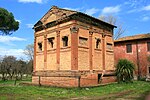Annunciazione della Beata Vergine Maria a Via Ardeatina
20th-century Roman Catholic church buildings in ItalyRoman Catholic churches completed in 1987Rome Q. XX ArdeatinoTitular churches
Annunciazione della Beata Vergine Maria a Via Ardeatina is a 20th-century parochial church and titular church on the southern edge of Rome, dedicated to the Annunciation and located on the ancient Via Ardeatina.
Excerpt from the Wikipedia article Annunciazione della Beata Vergine Maria a Via Ardeatina (License: CC BY-SA 3.0, Authors).Annunciazione della Beata Vergine Maria a Via Ardeatina
Via di Grotta Perfetta, Rome Municipio Roma VIII
Geographical coordinates (GPS) Address External links Nearby Places Show on map
Geographical coordinates (GPS)
| Latitude | Longitude |
|---|---|
| N 41.835690017056 ° | E 12.512023138847 ° |
Address
Chiesa della Santissima Annunziata a Via Ardeatina (Parrocchia SS. Annunziata)
Via di Grotta Perfetta
00014 Rome, Municipio Roma VIII
Lazio, Italy
Open on Google Maps










